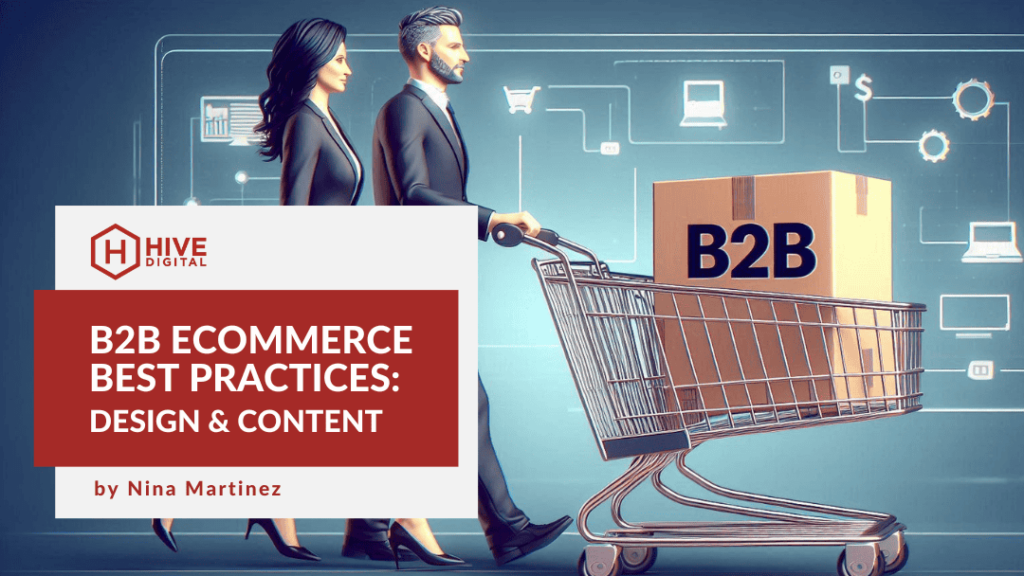For B2B ecommerce brands, having a well-designed landing page can be the difference between securing a high-value lead and losing potential business. B2B landing pages serve as the front door to your digital presence, offering a critical opportunity to position your brand, communicate your value proposition, build trust, and drive conversions. In this blog post, we’ll explore the best practices for creating B2B ecommerce landing pages that engage, inform, and convert:
1. Clear and Compelling Value Proposition
The first thing visitors should see when they land on your page is a clear and compelling value proposition. Your headline and subheadline should succinctly convey what your business offers and why it’s unique. Supporting visuals, such as images or videos, can further enhance your message by illustrating the benefits of your products or services. Remember, first impressions matter—make yours count!
Practical Tip: Use A/B testing to experiment with different headlines and subheadlines. Track which variations lead to higher engagement and conversions, and optimize accordingly.
2. Intuitive and Professional Design
A clean and organized layout is essential for a professional B2B landing page. Clutter-free design not only improves user experience but also keeps visitors focused on key messages. Consistency in branding, from color schemes to typography, helps reinforce your brand identity. Additionally, ensure your page is responsive, offering an optimal viewing experience across all devices—desktop, tablet, and mobile.
Practical Tip: Utilize a grid layout to maintain visual balance and organization. Tools like Figma, Mockflow, or Adobe XD can help you design clean, professional-looking layouts that adhere to your brand guidelines.
3. Effective Call-to-Actions (CTAs)
Your landing page’s primary goal is to convert visitors into leads or customers. To achieve this, strategically place clear and action-oriented CTAs throughout the page. Whether it’s “Get a Quote,” “Contact Sales,” or “Request a Demo,” your CTAs should be easy to find and compelling enough to encourage action. Offering multiple CTAs can cater to visitors at different stages of their buying journey.
Practical Tip: Use contrasting colors for your CTAs to make them stand out. For example, if your brand colors are blue and white, a bright orange CTA button can draw attention.
4. Trust and Credibility Elements
Building trust is crucial in B2B transactions, where decision-making processes often involve multiple stakeholders. Incorporate testimonials, reviews, retention rates, case studies, and success stories to showcase your proven track record. Displaying trust badges, industry certifications, client logos, and any guarantees can further enhance your credibility, reassuring potential clients of your reliability and expertise.
Practical Tip: Incorporate a slider or carousel featuring client logos or testimonial quotes. This format allows you to display multiple testimonials without overwhelming the page.
5. Engaging and Informative Content
Content is king, especially in the B2B space where purchasing decisions are research-driven. Provide detailed information about your products or services, highlighting key features and benefits. Diversify your content by including videos, blogs, whitepapers, and webinars, catering to different preferences and learning styles. Ensure your content is SEO-friendly, with relevant keywords, meta tags, and descriptions to enhance visibility in search engine results.
Practical Tip: Create a resource library on your landing page where visitors can download whitepapers, case studies, or watch product demo videos. “Gating” this content is a popular tactic for lead generation, asking for an email address in exchange for the content; though, also popular, is enhancing the users’ trust and perception of your brand authority by leaving the content ungated.
6. User Experience (UX) Optimization
A seamless user experience can significantly impact your landing page’s effectiveness. Fast loading speeds are essential to reduce bounce rates and keep visitors engaged. Easy navigation, including clear menus, search functionality, and breadcrumb trails, helps users find the information they need quickly. Don’t forget about accessibility—ensure your page complies with standards like ADA and WCAG to cater to all users.
Practical Tip: Use tools like Google PageSpeed Insights to analyze and improve your page’s loading speed. Compress images and leverage browser caching to enhance performance.
7. Lead Generation Forms
Lead generation forms are a vital component of B2B landing pages. To maximize conversions, keep forms short and only ask for essential information. Clear instructions and privacy assurances can help alleviate concerns and encourage form completion. Remember, the easier you make it for visitors to engage, the more likely they are to convert.
Practical Tip: Implement progressive profiling to gradually collect information from returning visitors. Start with basic details (name and email) and request more information on subsequent visits.
8. Personalization and Targeting
In the competitive B2B market, personalization can set you apart. Use segmented messaging to tailor content and offers to different audience segments. Dynamic content, such as personalized recommendations based on user behavior, can enhance engagement. For high-value accounts, consider using Account-Based Marketing (ABM) strategies to create customized experiences.
Practical Tip: Use marketing automation tools like HubSpot or Marketo to segment your audience and deliver personalized content. For example, tailor messaging based on industry, company size, or previous interactions.
9. Analytics and Performance Tracking
To continuously improve your landing page, it’s essential to track its performance. Monitor key metrics like click-through rates (CTR) and conversion rates to gauge effectiveness. Regularly conduct A/B testing on headlines, CTAs, and layouts to identify what resonates best with your audience. Collecting and analyzing user feedback can also provide valuable insights for ongoing optimization.
Practical Tip: Set up Google Analytics goals to track specific actions, such as form submissions or downloads. Use heatmaps (e.g. Microsoft Clarity, Hotjar, or CrazyEgg) to understand user behavior and identify areas for improvement.
10. Compliance and Legal Considerations
Lastly, ensure your landing page adheres to legal and compliance standards. Include easily accessible links to your privacy policy and terms of service. For businesses handling data from EU citizens, GDPR compliance is a must. Additionally, inform users about cookie usage and obtain consent where required.
Practical Tip: Use a cookie consent banner that explains your data collection practices and allows users to opt in or out. Tools like OneTrust can help you implement and manage compliance features easily.
Key Takeaways
A well-crafted B2B ecommerce landing page is a powerful tool for driving business growth. By following these best practices, you can create landing pages that not only attract and engage visitors but also convert them into loyal customers. Remember, the key to success lies in continuously optimizing your landing page based on performance data and user feedback. Happy optimizing!
If you’re interested in learning more about these tactics and/or how they can be applied to your digital strategy, feel free to connect with our team for your free consultation.










